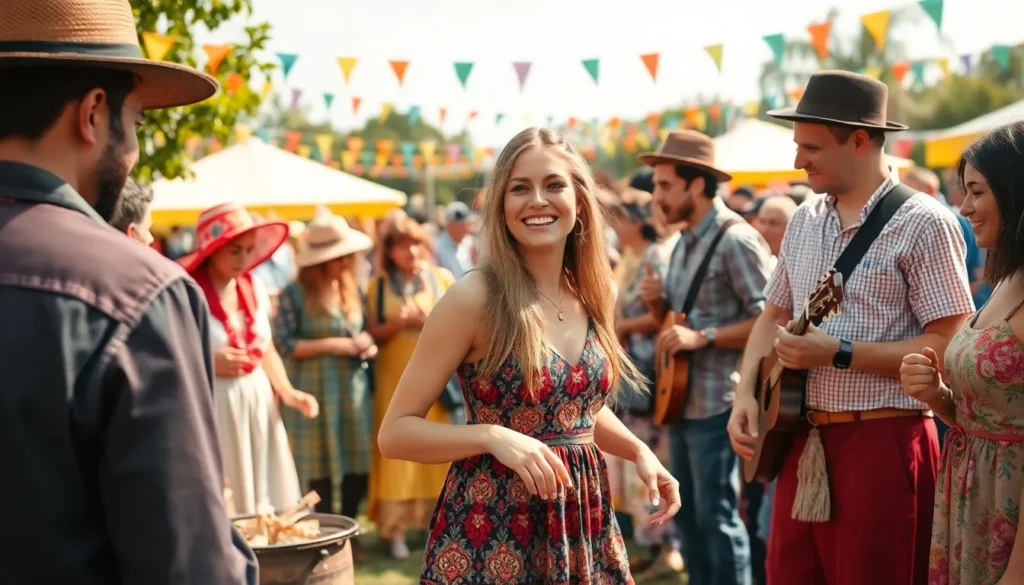From the colorful festivals of India to the solemn rituals of Japan, world traditions bring a vibrant tapestry of culture to life. Each tradition tells a story, connecting people through laughter, food, and the occasional awkward dance move. Who wouldn’t want to dive into the delightful quirks that make our global family so unique?
Table of Contents
ToggleOverview of World Traditions
World traditions encompass a wide array of practices and customs that characterize different cultures across the globe. These traditions often reflect historical backgrounds, beliefs, and communal values that have been passed down through generations. Each culture boasts unique elements, such as rituals, festivals, and crafts, that offer insight into their distinctive identities.
Celebratory events serve as a focal point for many world traditions. Examples include the Chinese New Year, Diwali in India, and Thanksgiving in the United States. Each of these festivities involves specific customs, food, and activities that unite families and communities. Traditions often bring people together for shared experiences that foster connection and belonging.
Culinary practices represent another vital aspect of world traditions. Diverse dishes, such as sushi from Japan, paella from Spain, and poutine from Canada, provide a glimpse into local ingredients and cooking methods. Food traditions not only highlight cultural heritage but also facilitate communal gatherings and rituals, reinforcing social bonds.
Artistic expressions also play a significant role in world traditions. Various art forms, including music, dance, and visual art, reflect the creativity and values intrinsic to each culture. Traditional dances, like the tango in Argentina or the hula in Hawaii, celebrate stories and histories that define their communities.
Furthermore, traditional clothing and attire contribute to the global cultural landscape. Distinct garments, such as kimonos in Japan, saris in India, and kilts in Scotland, showcase cultural artistry and identity. These clothing items often serve specific ceremonial purposes, embodying the significance of cultural narratives and historical events.
In essence, world traditions create a rich tapestry that connects diverse peoples through shared customs and experiences. Embracing these traditions encourages appreciation for the intricate diversity that shapes our global community.
Major Categories of World Traditions


World traditions encompass a variety of practices that reflect humanity’s shared heritage. They can be categorized into cultural, religious, and social traditions, each contributing uniquely to the cultural landscape.
Cultural Traditions
Cultural traditions include various forms of artistic expression and culinary practices that define communities. Festivals like Carnival in Brazil celebrate music, dance, and vibrant costumes, showcasing local creativity. Culinary customs, including the preparation of traditional dishes, emphasize local ingredients and family recipes passed down through generations. Storytelling practices, such as oral histories in Africa, preserve cultural values and heritage, fostering connection among community members. Traditional clothing represents identity, with garments like saris in India and kilts in Scotland symbolizing deep-rooted customs and pride.
Religious Traditions
Religious traditions play a vital role in shaping beliefs and practices around the world. Annual observances like Ramadan in Islam and Hanukkah in Judaism illustrate the varied ways people express faith and spirituality. Rituals, such as marriage ceremonies in different cultures, often reflect the values of love, family, and commitment central to their beliefs. Pilgrimages, like the Hajj to Mecca, demonstrate commitment and devotion within various religions, uniting followers through shared experiences. Sacred texts, alongside oral teachings, serve to guide adherents in these practices, ensuring the continuity of faith across generations.
Social Traditions
Social traditions focus on the customs that influence interpersonal relationships and community interactions. Family gatherings during holidays, such as Thanksgiving in the U.S., highlight the importance of unity and gratitude. Social etiquette varies significantly; for instance, greeting customs differ widely, from bowing in Japan to handshakes in Western cultures. Community events, like neighborhood block parties, foster social bonds and strengthen local ties, promoting a sense of belonging. Celebrations of milestones, including anniversaries and graduations, emphasize shared joy and support, illustrating the fundamental human desire for connection and togetherness.
Unique Traditions Around the Globe
World traditions showcase the rich diversity of cultural practices worldwide. They illustrate how communities express their identities and shared experiences.
Festivals and Celebrations
Various festivals and celebrations highlight cultural uniqueness. Chinese New Year brings families together through vibrant parades, lanterns, and fireworks, celebrating new beginnings. In India, Diwali symbolizes the triumph of light over darkness, marked by intricate decorations and festive meals. Brazil’s Carnival captivates with lively samba music and colorful costumes, attracting tourists and locals alike. These events foster unity and cultural pride, creating memorable experiences through communal involvement. Each celebration reflects historical significance and collective joy.
Culinary Traditions
Culinary traditions present a vital aspect of cultural heritage. Japanese sushi emphasizes fresh ingredients, carefully prepared to enhance flavor and presentation. Spain’s paella showcases rice, seafood, and saffron, often enjoyed during family gatherings. Ethiopian injera, a sourdough flatbread, serves as both a dish and utensil, symbolizing community dining. Similarly, Italian pasta varies regionally, with each variation representing local ingredients and history. Culinary practices often strengthen social bonds, allowing individuals to connect through shared meals and traditions.
The Importance of Preserving World Traditions
Preserving world traditions holds significant value for cultural identity and community cohesion. Communities thrive on memories and stories that these traditions encapsulate. By maintaining practices like the Chinese New Year or Thanksgiving, individuals strengthen familial bonds and cultural connections.
Traditions serve as links to history, reflecting the beliefs and values of past generations. Each festival, such as Diwali or Brazil’s Carnival, contributes to a shared cultural narrative. Festivals not only attract participation but also attract tourism, fostering mutual respect and understanding among different cultures.
Food traditions provide insight into local resources and shared experiences. Culinary practices, such as making sushi or paella, reinforce community ties during gatherings. Unique dishes symbolize regional identities and convey cultural heritage.
Moreover, artistic expressions, such as traditional dance or folk music, celebrate cultural creativity and narratives. Customs vary widely, yet they all enhance the vibrancy of the global cultural landscape. Clothing styles, like kimonos or saris, showcase historical significance and individual identity.
Recognition of world traditions promotes global awareness and appreciation. Identifying cultural differences helps reduce misunderstandings and encourages collaboration among nations. Emphasizing inclusivity supports ongoing efforts to safeguard diverse heritages.
Strengthening efforts to document and teach these traditions ensures younger generations remain connected to their cultural roots. With education, traditions thrive in new contexts, adapting to modern society while retaining essential elements. Ultimately, the collective preservation of world traditions enhances global unity and drives cultural enrichment.





